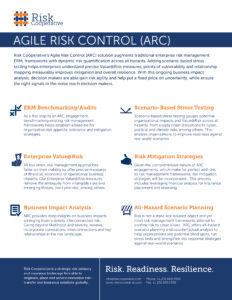Advisory Services
Enterprise Risk Management Consulting
Enterprise risk management (ERM) is a holistic approach that helps organizations build operational resiliency.
Implementation of an ERM program can reduce potential losses and risks to an organization as well as facilitate improvements in resource allocation, capital outlay and management decision making. Risk Cooperative works with organizations to develop and implement ERM strategies that are designed to align risk management activities with key business objectives.
The Risk Cooperative ERM methodology is designed to help provide effective and proactive risk management and mitigation. This ensures all components of the ERM program work well together, across divisions and in conjunction with the organization’s overall strategy. This process helps to clearly define roles and responsibilities, so that policies and procedures can be best implemented and utilized across the entire enterprise. Lastly, this model helps to develop a standardized risk lexicon and rating methodology. Our ERM Consulting provides a common language and understanding that enables more efficient and effective decision making, as well as stakeholder management within the organization.
ERM Components
Benchmarking and Gap Analysis
Benchmarking risk management frameworks helps establish a baseline for measurement and ongoing improvement and identify gaps within the organizations risk management and mitigation program
Risk Identification and Assessments
Develop precise measures of financial, economic or operational business impacts from identified risks.
Risk Analysis and Evaluations
Help the organization compare to its industry peers and determine additional steps to limit potential risks.
Risk Appetite and Threshold Development
Assess an organizations overall risk appetite to develop an enterprise threshold for risk exposures.
Risk Reporting and Monitoring
Customized, data-driven support designed to enable risk-aware decision making.
ERM Framework Design and Implementation
We work with clients to develop customized ERM frameworks that can be implemented across the enterprise.
Resource Library
Putting ethics front and centre of senior management decision makers is vital if risk managers want to stay ahead of ethical violations.
With the growing number of firms falling prey to cyber risk, governance failures and market forces, there is a need for greater agility in how decisions are made and risks confronted. Yahoo!, with its record-breaking cyber breach estimated at more than 500 million records, and Wells Fargo are but two firms to face complex challenges and an unwanted public excoriation. Like VW’s emissions scandal or the warning signs that could have prevented the Germanwings disaster, it is time for senior business leaders and their boards to change the way they think about risk and therefore how they respond to it.
Complex systems fail in complex ways. Many of these failures are either fueled by or missed in the byzantine maze that is the modern enterprise. Addressing these organizational blind spots requires equipping people with common levels of risk awareness, codes of conduct and alignment to value systems. A maxim is a general truth, fundamental principle, or a rule of conduct that can be helpful in creating this alignment. The following risk maxims can help reduce complex enterprise risk management principles into actionable guidelines and patterns of behavior at all organizational levels.
1 | Values matter most when they are least convenient – When confronted with challenging situations, value systems are meant to guide behavior and decision making. After 9/11 the Geneva Conventions took on entirely new meaning in the U.S., just like Johnson and Johnson’s now famous Tylenol recall in the 1980’s was informed by the firm’s credo to put the people they serve first.
2 | Sunlight is a great disinfectant – In the age of rampant cyber risk and unwanted disclosure, privacy is a luxury. The negative effects of the Sony Entertainment hack were amplified by inconsistent behavior among top officials. Contrasted to the leak of Mossack Fonseca’s Panama Papers, few were surprised by the misdeeds of dictators and nefarious government officials.
3 | Make it everyone’s business to stay in business – Firing the whistleblower breeds organizational indifference. The notion of skin in the game helps create both a sense of loss aversion and preservation that is critical to firm survival. Agile enterprises are connected through firm-wide networks of people who share and respond to risk information (the signals in the noise) in real time.
4 | There are no constants – Like in weather patterns and market forces, there are no constants in risk management. It is safe to assume high degrees of variability over time and therefore dynamic approaches should be applied to managing risk rather than passive ones.
5 | Tone (and distance) at the top matter – Attitudes towards risk are deeply informed by the tone, tenor and remoteness at the top. Leaders who practice what they preach, have conviction and lead by example are better at managing risks than those that merely pay lip service to risk, compliance and codes of conduct.
6 | Risk lies between the chair and the keyboard – In the era of man-made risk, internal and external threats emerge from human behavior. Unlike naturally occurring risks, man-made risk has agency and therefore a higher degree of planning. Incentive systems and deep stakeholder engagement can help reduce the incidence and severity of these risks.
7 | You can’t decouple the fortunes of companies from countries – Firms of all sizes are finding it increasingly difficult to shelter themselves behind their fortress balance sheets, protect their supply chains, people, systems and market access from global risks. At the same time they have a unique duty to invest in slowing down the decline of the global business commons on which they depend. Forming strategies that incorporates a foreign policy can address this tension
8 | Bad things happen in the dark – Moral hazards arise when people take risks but do not bear the downside of their risky behavior. These hazards are most prevalent under the cover of darkness, in remote locations and where incentive systems are not aligned. Combating moral hazards begins with having transparency, accountability and clear guiding principles that hold economic, social and environmental impacts in balance.
9 | Simplicity is key – Just as David was able to slay Goliath with a simple instrument, the sling, complex risks are best addressed with simple measures. Encouraging bounded risk taking and reducing fear of failure can help hone an organization’s broad senses – muscle memory – on how to respond to emerging threats and complex risk relationships.
10 | Embark on a zero-failure mission – The airline industry like elite units in the military boast of one of the best performing risk management records. The reason is that the consequences of failure are dire and all parties typically have skin in the game. This zero-failure approach should be adopted across industries.
Firms should not embrace risk agility out of fear of failure or mere compliance. Risk agility is a source of lasting competitive advantage. After all, when the competitive landscape is littered with the tombstones of firms that failed to understand and respond assertively to risk, the agile enterprises will inherit the spoils.
Originally published on Strategic Risk, May 2019.
When the Dean of Harvard Business School, Nithin Nohria, gave his inaugural interview with the school’snewspaper The Harbus in September 2010, he discussed the important role business plays in society.
“My father was CEO of Crompton Greaves in India. I saw the impact business could have in transforming communities through better infrastructure and creating employment opportunities,” he said.
Dean Nohria’s views are more important than ever, and the current COVID-19 pandemic has put business to the ultimate test.
As the U.S. prepares for what will be many weeks of social distancing, teleworking and drastically changing daily operations, it is critical that business plays a leading role in navigating these turbulent waters both during and after the threat.
Grande Americano, Leave Extra Room for Employee Well-Being
Given the rise of mental health awareness among U.S. companies, it is important for employers to find accessible solutions to support their employees both during this crises as well as when a sense of normalcy returns. We need look no further than a ubiquitous coffee company to find the perfect blend.
Starbucks adopted a novel approach to addressing employee mental wellness, according to Fast Company. Starbucks employees, and their family members, have access to 20 free annual therapy sessions through mental health provider Lyra Health. Launching on April 6th, the timing of this employee benefit could not be better given the impact of the pandemic on society.
Starbucks employees can schedule appointments with mental health professionals conveniently and quickly via a smartphone app. Employees even have the option to conduct sessions online, further diversifying the delivery method of this important benefit.
Fresh Food, How Sweet It Is
Sweetgreen is expanding its Outpost concept to health care workers. The fast-casual chain is connecting hospitals to its fresh food free of charge in the various cities it serves. World-renowned chef Jose Andres has once again mobilized his World Central Kitchen to not only feed emergency responders but also feed students no longer able to eat at shuttered schools as well as the elderly unable to leave their homes.
Many restaurants across the country have successfully shifted from dine-in concepts to curbside pick-up operations. One such restaurant in Washington, D.C., i ricchi, has created a food club allowing residents to not only schedule pick-ups each day of the week but also to prepay food for others in need (the recently unemployed, emergency responders, frontline workers, etc).
Providing a Much-Needed Assist
Bauer, a manufacturer of hockey equipment for professional and amateur athletes, has pivoted from making helmet visors for players to face shields for medical professionals. According to The Washington Post, the company has received over 1 million orders for these shields.
While Bauer is operating its production facilities at maximum capacity, the firm cannot meet the current backlog, so it has provided design/manufacturing instructions to other companies in an effort to encourage increased production capacity.
The Washington Post also reported that Fanatics, a maker of sports apparel, has also redesigned its assembly line to produce more protective face shields.
There Is Such a Thing as a Free Ride
Hertz is making transportation more accessible to those on the front lines. According to its website, the car rental behemoth is offering health care workers in New York City a free, month-long rental throughout the month of April.
Lessons Learned Upon a Return to Normalcy
Similar to the way U.S. citizens banded together in the aftermath of 9/11, so too shall this nation become stronger post-pandemic. This resiliency is especially important given that future communicable diseases/pandemics are likely to come.
If history is any guide, SARS, MERS, Avian Flu, H1N1 and COVID-19 are the forefathers of maladies on the horizon. Risk managers are the “center of excellence” within an enterprise risk management framework, and it is incumbent upon them to remain proactive and prepared.
While industrial giants such as Ford, GE, 3M, Tesla, Airbus and Dyson have redesigned their assembly lines to produce much-needed ventilators for hospitals combating the pandemic, risk managers at these organizations must determine how they can continue their important work in future years.
One idea is for these firms to strategically stockpile ventilators for free in their plants around the globe, ready to absorb surge capacity at a moment’s notice. Similar to how the Climate Clean Air Coalition has formed a partnership of businesses, civic groups and governments committed to improving the global climate, companies producing ventilators can form a similar partnership under the oversight of a governing body like The World Health Organization.
This resilient supply chain can save lives and lessen the impact of future pandemics. The same thought process can be used for distilleries across the nation that have converted some of their operations from making alcohol to making hand sanitizer for hospitals in the region.
Bauer has created the perfect blueprint for how companies, including rivals, can work together and share information to meet surge capacity during the next pandemic.
Now that the U.S. is witnessing the impact of mental health on frontline workers, risk managers should consult with HR to understand how they can better address their employees’ mental health needs.
Starbucks is on the right track, by taking care of their employees now. They are creating a more resilient organization and building goodwill, which may lead to a reduction in employee turnover, improved well-being/mental health and increased productivity.
By observing Dean Nohria’s views on business, risk managers can position themselves at the leading edge of organizations that create resilient communities outlasting any future crises.




